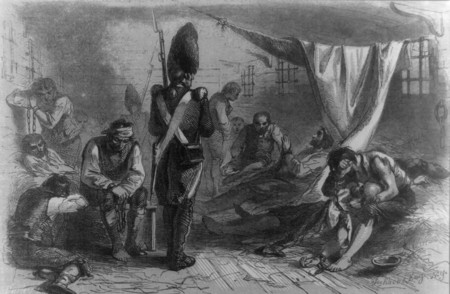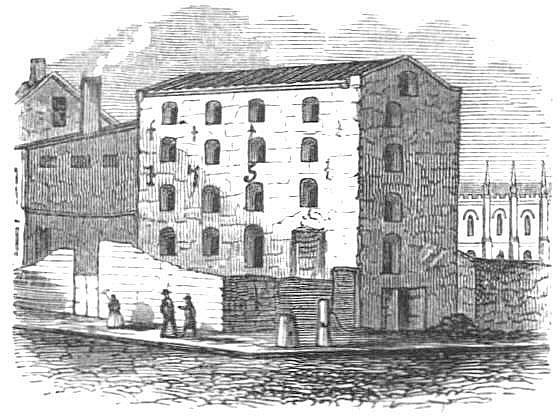
Forgotten Patriots by Edwin G. Burrows
 Readers of this book should expect to be surprised. Although the cover promises “The untold story of American Prisoners during the Revolutionary War,†the author delivers much more. In rescuing these men from the oblivion to which historians, for a variety of reasons and circumstances, consigned them, Burrows reveals a great deal about our national beginnings and the people and events that shaped America.
Readers of this book should expect to be surprised. Although the cover promises “The untold story of American Prisoners during the Revolutionary War,†the author delivers much more. In rescuing these men from the oblivion to which historians, for a variety of reasons and circumstances, consigned them, Burrows reveals a great deal about our national beginnings and the people and events that shaped America.
And while he also reveals the avarice, cruelty, political chicanery, stupidity and arrogance, which are so often the companions of power, he represents honor, courage, decency and sacrifice as well.
Individuals who played major and minor roles in this compelling story include Ethan Allen, Benjamin Franklin and Tory son William; the disgraced and duplicitous General Charles Lee, (whom George Washington once called “a damn poltroonâ€); the unfortunate Judge Richard Stockton, the only signer of the Declaration of Independence to be taken captive; David Sproat, commissary of naval prisoners known for his indifference to the suffering of prisoners in his charge; and many others whose valor or perfidy have hitherto been unremarked.
Burrrows writes with the objectivity of the historian he is, but only a dull reader will miss the author’s passion for the forgotten patriots his words have exhumed from the mass graves in which they have been buried for over 200 years.
An estimated 200,000 Americans went to war against the British crown. Of these 6,824 died in combat and another 10,000 succumbed to wounds or disease in camp. Burrows writes that of the 23,850 to 32,000 Americans interned in and around Manhattan, the total who perished, including 11,000 believed to have died on British prison ships, ranged from 15,575 to 18,000 men; in other words, between two and three times the number killed in battle, and 50% more than those who died in camp. Burrow’s book is the first account of what took place in British prisons.
He begins with the Battle of Brooklyn on August 27, 1776, the biggest battle of the Revolutionary War and one that dealt the Continental Army a potentially fatal blow.  Hugely outnumbered, ill trained and poorly equipped, the colonials were, in the words of one British officer, dispatched with bayonets “after we had surrounded them so they could not resist.â€
Those who survived surrender presented a logistical problem for General Howe, commander of the British force. To deal with the problem, Howe appointed a Boston Tory named Joshua Loring as his commissary general of military prisoners.  Burrows writes, Loring “possessed two unbeatable qualifications for the job: a settled conviction that men who took arms against their sovereign deserved no mercy, and a beautiful wife, to whom the general had taken a fancy (Loring ‘fingered the cash,’ quipped the Tory historian Thomas Jones, while the General enjoyed the madam).’â€1
 The prisoners were, according to established British practice, held in vessels of the invasion fleet until the British gained possession of New York City and located quarters in which to confine them.  However, New York was a ruined city and didn’t offer many options.  Few residents remained among the shattered buildings, but there were throngs of Tory refugees seeking British protection; runaway slaves in search of safe haven; and a British force of more than 33,000 men plus their American captives whose numbers increased with each battle.  Provisioning was an on-going problem. Either due to shortages or because the jailors sold their food, the prisoners received meager rations of the poorest quality.  Some later credited their survival to the kindness of a few city residents who shared what little food they had.
The prisoners were, according to established British practice, held in vessels of the invasion fleet until the British gained possession of New York City and located quarters in which to confine them.  However, New York was a ruined city and didn’t offer many options.  Few residents remained among the shattered buildings, but there were throngs of Tory refugees seeking British protection; runaway slaves in search of safe haven; and a British force of more than 33,000 men plus their American captives whose numbers increased with each battle.  Provisioning was an on-going problem. Either due to shortages or because the jailors sold their food, the prisoners received meager rations of the poorest quality.  Some later credited their survival to the kindness of a few city residents who shared what little food they had.
The buildings in which the men were kept, Liberty House, Provost Jail, Sugar House and various commandeered Protestant (never Anglican) Churches, became infamous for brutal overcrowding, lack of sanitation, rampant disease, and starved prisoners. The Provost jail, where high-ranking officers and civilians accused of supporting the rebellion were kept, was known for the deliberate brutality of Provost Marshal Captain William Cunningham.
 Beyond the sadism of men like Cunningham, there were other forces that determined prisoners’ treatment. Burrows writes, “My reading of the evidence is that the thousands of Americans who perished in New York during the Revolution were the victims of something well beyond the usual brutalities and misfortunes of war, even eighteenth century war—a lethal convergence, as it were, of obstinacy, condescension, corruption, mendacity, and indifference.â€
Beyond the sadism of men like Cunningham, there were other forces that determined prisoners’ treatment. Burrows writes, “My reading of the evidence is that the thousands of Americans who perished in New York during the Revolution were the victims of something well beyond the usual brutalities and misfortunes of war, even eighteenth century war—a lethal convergence, as it were, of obstinacy, condescension, corruption, mendacity, and indifference.â€
Although European wars produced some humane precepts and customs regarding prisoners, none of these were yet codified in treaties or conventions. Â Enforcement of unwritten guidelines was uneven at best and whether these guidelines even applied in cases of domestic insurrection or rebellion was an open question.
“The thousand-odd Americans who surrendered during the Battle of Brooklyn thus faced a future fraught with unusual peril.  Unprotected by international agreements or by the code of honor that regulated the conduct of officers and gentlemen, they were at the complete mercy of their enraged captors.  As Captain MacKenzie of the Royal Welsh Fusiliers wrote soon after the battle, captured Americans should not really be considered prisoners of war at all.  They were nonpersons, to be used in any way that would most effectively put an end to the resurrection.â€
There was a social chasm between British officers and those of the Continental Army. Â British officers were wealthy gentlemen from leading families who subscribed to a code of honor in dealing with equals. Â The shopkeeper and farmer officers of the Continental Army were deemed unworthy of being treated as gentlemen. Â To make matters worse, although Americans believed they were defending their traditional rights as Englishmen, the perception on the other side of the Atlantic was very different. Â Captured Americans were not viewed as enemy combatants, but as rebels guilty of sedition and treason.
Colonial defiance came at a time when the Empire was shaken by turbulence in Scotland and Ireland.  Thus the King and many in Parliament saw the American insurrection as a threat to national unity and stability.  Doctor Samuel Johnson epitomized this view, calling the Americans “a race of convicts†that “ought to be thankful for anything we allow them short of hanging.â€
It should not surprise that officers of his Majesty’s armed forces in America reflected these attitudes.  Washington’s many letters of complaint to General Howe regarding the treatment of American prisoners were either ignored or dismissed with false denials.
As the war progressed and it became impossible to cram more prisoners into already overcrowded buildings, they were confined in troop transports anchored in Wallabout Bay, now known only as the site of the old Brooklyn Navy Yard. The author describes a shipboard hell where men were confined below decks in conditions so crowded that they could not lie down at the same time, packed so tightly that some suffocated.  They subsisted on rations barely sufficient to sustain life and breathed air so putrid that men fought for space at the deck grates.  Nor were things any easier for the thousands locked up on land.  Wormy food, putrid water, random floggings and so much sickness that burial parties would remove ten or twenty bodies each morning.
The terrible treatment of American prisoners weighed on George Washington. Burrows reveals that he threatened to retaliate in kind against British captives, but never carried out the threat. Rather, he was determined that enemy prisoners be treated humanly and, with few exceptions, they were.
Readers will learn that while George Washington was fighting the Redcoats, he was also at war with Congress over, among other things, the absence of a formal agreement for the regular exchange of prisoners, an established practice among combatants.
 American newspapers printed hundreds of letters, affidavits and other accounts testifying to the horrific conditions of the American prisoners. Washington’s complaints to General Howe elicited continued denials of what had become common knowledge.  Washington badgered Congress to appoint a commissary general for prisoners to supply food, clothing and other essentials to American prisoners and to care for enemy captives.  In 1777 Congress complied.  The author describes the valiant efforts of commissaries Lewis Pintard and Elias Boudinot to obtain supplies for American prisoners.  When Boudinot discovered that Congress had no money to spend on  the prisoners, he spent his own, putting himself in debt.  He could not nearly meet the need, but it was better than nothing at all. Burrows writes, “Washington had said he wanted ‘a shrewd sensible man’ for the job of commissary general.  The man he got was a saint.â€
American newspapers printed hundreds of letters, affidavits and other accounts testifying to the horrific conditions of the American prisoners. Washington’s complaints to General Howe elicited continued denials of what had become common knowledge.  Washington badgered Congress to appoint a commissary general for prisoners to supply food, clothing and other essentials to American prisoners and to care for enemy captives.  In 1777 Congress complied.  The author describes the valiant efforts of commissaries Lewis Pintard and Elias Boudinot to obtain supplies for American prisoners.  When Boudinot discovered that Congress had no money to spend on  the prisoners, he spent his own, putting himself in debt.  He could not nearly meet the need, but it was better than nothing at all. Burrows writes, “Washington had said he wanted ‘a shrewd sensible man’ for the job of commissary general.  The man he got was a saint.â€
Benjamin Franklin saw the abuse of American prisoners as irreconcilably severing ties with the mother country.  “When the war was over and independence assured, he would look back on the refusal of thousands of ordinary men to abandon the cause while in captivity, even at the cost of their lives, as ‘glorious Testimony in favor of plebian Virtue.’” British military and naval recruiters regularly combed the prisons and prison ships for defectors.  It was said that prisoners were treated harshly to make them switch sides.  Some did so and some then deserted at the earliest opportunity, returning voluntarily to their own lines with news of enemy troop strength and location.  Many more risked death rather than abandon their honor and their country.
Burrows is appalled that the sacrifices of these patriots have been forgotten.
Local politics, and the destruction of the prisons to make room for the rapidly growing city made it difficult to remember the horrors that took place in them. However, the most enduring reason was Anglo-American reconciliation.
“For moderate and conservative patriots like Alexander Hamilton, the key to rebuilding and recovery was political reconciliation. Everything hinged on recognizing that the Revolution was finished…† Thus the Tories who had fled were welcomed back and their property restored.  Their money, connections and know-how were needed to build the new nation.
The passage of time did nothing to diminish that dynamic. Â The author writes,
“In the decades on either side of WWI, the deaths of thousands of captives during the Revolution was downgraded in American public opinion from an outrage to an embarrassment – a regrettable minor breach in the friendship of two kindred peoples.  Academic historians, eager to rescue the Revolution from flag-waving jingoism and personality cults, shelved the subject.â€
Forgotten Patriots rights that awful wrong.
1This story is somewhat doubtful in terms of provenance, but has nonetheless been oft perpetuated. Â Here is an interesting article by the Jamaica Plain Historical Society which advances the theory that while the lovely Mrs. Loring may not have been as careful of her reputation as she should have been, it’s unlikely that she was unfaithful to her husband.
 The posts are coming!
The posts are coming!


3 comments
Throughout history, the plight of P.O.W.s can be best described as unrelentingly hellish. Compared to most past P.O.W. facilities, our current Guantanamo camp is a 5-star hotel. Burrows’ book goes on my must-read list.
[Reply]
I am very glad you will read it. It is an incredibly rich source of never-before disclosed information about little known events and people. Burrows also writes extremely well so the combination makes it a book that is hard to put down.
[Reply]
This Was Very Useful Thank You
[Reply]
Leave a Comment